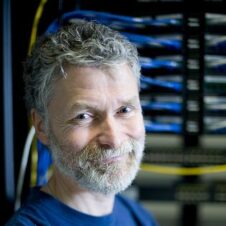Professor Andreas Wicenec
Professor Andreas Wicenec is a Research Professor and head of the Data Intensive Astronomy (DIA) program at ICRAR. Andreas is leading research efforts directed at the challenges of transmitting, storing and processing the enormous amounts of data generated from the radio telescope arrays being developed in Western Australia. He leads work on three main projects: (1) SKA Science Data Processor Data Layer design (2) Science Survey Support (3) High Performance Computing systems. Andreas joined ESO in 1997 as an archive specialist and was involved in the final implementation of the archive for ESO’s Very Large Telescope (VLT) and then became ESO’s Archive Scientist and led the ALMA archive subsystem development group.. During his early career he was involved in the software development and reduction of photometric and astrometric Tycho data from the Hipparcos satellite. Prof. Wicenec is also involved in the International Virtual Observatory Alliance (IVOA). His scientific interests and publications include high precision global astrometry, optical background radiation, stellar photometry, dynamics and evolution of planetary nebulae and observational survey astronomy and the related scheduling and computational concepts.

The interview below was conducted in 2012
What are you working on now?
I’m leading the Information and Communication Technologies (ICT) program of ICRAR. This includes four main projects:
- The Conceptual SKA Design (Andreas)
- Data Intensive Research Pathfinder (Andreas)
- High Performance Computing (Chris Harris)
- LSST collaboration on database research (Kevin Vinsen)
I’m also supervising a PhD student working on ultra-scale visualisation and two internship students working on archive infrastructure projects. All the projects and students are bound in to the ICT effort to support ICRAR’s scientists getting the best out of their data.
What got you into astronomy, and then what took you down the ICT path within astronomy?
I guess the landing on the moon in 1969 and all the stuff NASA did at the time really brought me into astronomy. I bought my first telescope at the age of 13 and just went on into a professional career in astronomy from there. Very similarly I started with computer stuff maybe at the age of 15 and more seriously with 17 learning my first computer language. When starting my diploma thesis in astronomy, the knowledge I’d gathered up to that point in the computing area turned out to be very valuable: I got involved in the data reduction of the HIPPARCOS satellite and that was the right mixture between IT and science for me.
Why is your work important for ICRAR?
ICRAR’s scientists will require vast amounts of compute power in order to be able to reduce and scientifically exploit the enormous amounts of data collected by ASKAP and the MWA. In addition ICRAR has a strong group of scientists performing large scale astrophysical simulations.
The ICT program provides HPC, database and general IT expertise and carries out R&D projects to support ICRAR scientists. This includes requirement gathering to advise iVEC in the planning and procurement of the various stages of the Pawsey supercomputing centre as well as R&D projects in database, storage and high performance computing in collaboration with various international partners and groups.
We also have a strong educational component supervising PhD and internship students and working together with all universities in Perth to establish computer science courses with more emphasis on supercomputing and the SKA.
Why did you join ICRAR?
ASKAP and the SKA are not just amazing astrophysical instruments, but also pose enormous challenges in data flow, data management and processing. It is exactly this mixture of astronomy and IT which is the niche I always liked to work in and being able to contribute to the SKA is really exciting. Apart from that Australia and Perth in particular indeed is a great place to live.
Where were you before you came to work for ICRAR?
I’ve been working for the European Organization for Astronomical Research in the Southern Hemisphere (ESO) for 13 years. I was involved in the design and implementation of various parts of the ESO science archive system and I’ve been leading the ALMA archive development team for about 8 years.
What’s your favourite part of your work?
Talking to astronomers about their research and trying to suggest and implement novel or improved ways to extract or visualise the key points of scientific interest. Being an astronomer myself, this obviously includes my own projects.
Do you have a highlight from your time so far with ICRAR?
Two main highlights for me are:
- We have been able to put forward our high level design ideas for the SKA into the SKA Project Execution Plan and
- The request for tender for the second of the Pawsey supercomputers closely matches the requirements we have been collecting during the last months for data intensive research
How do you think we’re going to solve the computing challenges facing astronomy in the next decade?
Not alone! We need to get help from vendors and computer and network manufacturers, but also from software experts. Apart from very specialised simulations, astronomy was never so close to the cutting edge of High Performance Computing. With the SKA we are challenging the whole IT world, plus some other industries, like power production and power grid providers. There are quite a number of smaller and bigger challenges to be tackled and thus we will need to establish collaborations in many areas, without losing the focus on the science goals. After all the, SKA is supposed to produce great science using ICT, not the other way around…